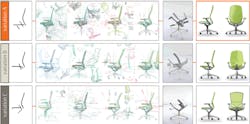Design Collaborative: Back to Basics
Sidebar: The Design Process
Too many people can unfortunately relate to the following experience: You go to sit in a chair but you can't easily find or operate the controls to adjust how you like to sit. If you've experienced this scenario—or your customers have—then Allsteel's new Acuity chair should definitely be considered for your future projects. This premium performance chair, which is perfect for any office setting, goes back to basics to meet customer needs.
Mark Roumfort, Allsteel's vice president, product development and management, says that Acuity's introduction reflects the company's philosophy toward its customers. "We continually explore innovative ways to solve our customers' problems. We believed there was an opportunity for us to expand our product portfolio to meet challenges our customers were experiencing related to seating."
Roumfort states that Allsteel personnel and their customers repeatedly discussed problems involving comfort and complexity—more comfort was needed while less complexity was also desired. While addressing the two concepts may seem simple, it was actually a daunting task.
"We spent two-and-a-half years developing Acuity—a process that involved looking at seating in new and different ways," explains Roumfort. "The chair has a beautiful, straight-forward aesthetic that belies the complex engineering hidden inside. The intuitive controls are located so that the user can easily see, reach and use them."
Allsteel's executives wanted to bring a fresh perspective to the chair's development process and elected to partner with Continuum, a Milan-based firm headed by Bruce Fifield. "Continuum is one of the world's leading industrial product development companies," says Grant Kenworthy, Allsteel's product business manager, seating. "Both companies have the same work styles and expectations regarding design and innovation, which resulted in a very successful collaboration."
One key aspect of the product's engineering success is AcuFit™, a combination of three important elements: weight-activated controls, a hybrid seat cushion, and a conforming mesh back and carrier combination. The weight-activated mechanism automatically adjusts to the user's body weight to provide a perfect alignment as positions change.
"Acuity is a chair where the individuals involved in both its design and engineering truly respected one another and listened to the expertise that both groups offered," explains Fifield, Continuum's founding partner. "We continually asked each other what people look for in a chair to determine how to meet that need."
From an aesthetic standpoint, Fifield notes that the team didn't want to develop a chair that says, "look at me." Instead, they wanted to create a chair with an artisan quality, featuring an industrial aesthetic with rich surfaces that transition easily from one to another. "The fit, finish and tailoring on Acuity elevates the quality of the seating experience," he says. "As one example, Allsteel's engineers found a better way to manufacture the chair's leather
component so that the stitching looks handmade. Every detail was critically analyzed."
The chair's conforming mesh back and carrier combination is available in four options: a graphite carrier with an onyx or graphite mesh; and a titanium carrier with graphite or silver mesh. A fitted upholstered jacket, which slips over the mesh to create a unique appearance, can also be specified. Finishes for the chassis and base include polished aluminum, silver and graphite.
Like many cars manufactured today, the chair's controls are located on both sides of the seat and are easily within reach—a natural evolution according to Fifield. "Fit-to-body" adjustments (seat height and depth) are located on the right side of the seat edge, while "fit-to-task" adjustments (tilt lock and recline tension) are on the seat's left side.
"We gave great attention to Acuity's design and manufacturing," says Fifield, "and that includes the chair's environmental properties. The chair is designed to last 10 years but will, we believe, last much longer. Recycled aluminum is used to manufacture Acuity and the aluminum can be recycled when the chair has reached the end of its useful life."
Other environmental attributes abound. Fifield notes that Acuity earned a Cradle-to-Cradle (C2C) Silver certification from McDonough Braungart Design Chemistry (MBDC) and also achieved Scientific Certification Systems (SCS) Indoor Advantage™ Gold certification.
More than 90 percent of Acuity's materials, by weight, can be recycled and 50 percent of the chair's original materials contain recycled content. When it comes to manufacturing, Allsteel is using wind power for production, which helps to offset carbon dioxide, a prominent greenhouse gas. Additionally, Allsteel's "take back" policy means that the company will pick up any Acuity chair that is no longer useful.
Below: Three design variations were explored and developed based on semantic analysis and preliminary responsive kinetic systems. The goal was to use as few lines as possible.
Below: Developing an aesthetic mechanism avoided the "black box" effect beneath the seat.
Below: Carefully considering the design of the part lines avoided the "sandwich" effect and the "frame" effect typical of an industrial aesthetic.
